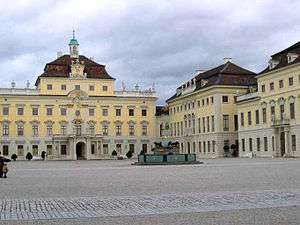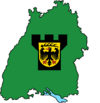Ludwigsburg Palace


Ludwigsburg Palace (German: Schloss Ludwigsburg) is a historical building in the city of Ludwigsburg (12 km north of Stuttgart's city centre), Germany. It is one of the country's largest Baroque palaces and features an enormous garden in that style.
From the 18th century to 1918 it was the principal royal palace of the dukedom that became in 1806 the Kingdom of Württemberg.
History
The foundation stone was laid on May 17, 1704 under Duke Eberhard Ludwig of Württemberg (reigning monarch from 1693 to 1733). One year later, the site was named "Ludwigsburg" (in English: "Ludwig's castle"). Begun as a hunting lodge, the project became much more complex and gained momentum over the years.
On August 17, 1709, the duke established the city of Ludwigsburg directly next to his palace, copying the proximity of Versailles to Paris. Previously, the royal palace was the cramped and outdated Old Castle (Altes Schloss) in the heart of Stuttgart. In 1718, Ludwigsburg temporarily became capital and sole residence of the dukes of Württemberg.
In 1733, when construction was complete, the baroque style prevailed in Germany. Eventually, successors of Eberhard Ludwig modified the original design of the palace, especially, Duke Charles Eugene of Württemberg and King Frederick I of Württemberg.
Today, three different styles are dominant:
- Baroque (e.g. Old Main Building, Rest Room of New Main Building, Building of the Giants, Games & Hunting Pavilions, Court Chapel)
- Rococo (e.g. Order Chapel, Duke's Private Suite, New Main Building) - modifications by Duke Carl Eugen
- Empire (e.g. Marble Hall, King's Audience Chamber, Queen's Bed Room, King's Library) - modifications by King Frederick I
The main architects involved in the construction and refurbishment of the site were Johann Friedrich Nette (from 1704 to 1714), Donato Giuseppe Frisoni (from 1714 to 1733), Philippe de La Guêpière (1757–1758), who built the Palace Theatre and refurbished the corps de logis in Rococo style, and Friedrich Thouret.

In the 1740s a New Palace was built in Stuttgart, and it was favoured by some of the dukes and kings of Württemberg as their primary residence, but Ludwigsburg remained in use as well. However, under King William I of Württemberg (reigned 1816-64), the palace and especially the gardens gradually decayed because the monarch, in contrast to his predecessors, showed no interest in Ludwigsburg. He favoured his own palace projects "Wilhelma" (Moorish) and "Rosenstein" (classical) in Stuttgart.
Ludwigsburg Palace was not destroyed during World War II, so a renaissance of the complex could start in the mid-20th century. The continuous garden show "Baroque in Bloom" (Blühendes Barock), that attracts hundreds of thousands of visitors each year, opened in 1953. Today, the palace and its surrounding gardens are presented to the public in a state similar to their appearance around 1800.
Some scenes of Stanley Kubricks Barry Lyndon were filmed in the palace.[1]
The palace theatre (Europe's oldest preserved theatre) and its stage machinery from 1758 are still operational.
Ludwigsburg Palace today contains three museums:
- Baroque Gallery (Old Main Building) - a branch of Stuttgart State Gallery - presents the State Gallery's collection of Baroque paintings
- Porcelain Museum (New Main Building) - a branch of Württemberg State Museum Stuttgart
- Baroque Fashion Museum - a branch of Württemberg State Museum Stuttgart - presents clothes from 1750 to 1820
Two smaller palaces complete the royal estate at Ludwigsburg: the "Favorite" (built from 1713 to 1728) and "Monrepos" (built from 1764 to 1768).
Burials in the Schlosskirche
- Prince Frederick of Württemberg
- Prince Paul of Württemberg
- Princess Charlotte of Saxe-Hildburghausen
- Catharina of Württemberg
- Eberhard Louis, Duke of Württemberg
- Johanna Elisabeth of Baden-Durlach
- Charles Alexander, Duke of Württemberg
- Princess Marie Auguste of Thurn and Taxis
- Charles Eugene, Duke of Württemberg
- Louis Eugene, Duke of Württemberg
- Duchess Sophia of Beichlingen
- Frederick II Eugene, Duke of Württemberg
- Margravine Friederike of Brandenburg-Schwedt
- King Frederick I of Württemberg
- Queen Charlotte Augusta Matilda
- Pauline Therese of Württemberg
- Princess Florestine of Monaco
- Wilhelm, Duke of Urach
- Théodolinde de Beauharnais
- Wilhelm Karl, Duke of Urach
- Duchess Amalie in Bavaria
- Philipp Albrecht, Duke of Württemberg
See also
References
- ↑ Germany, Stuttgarter Zeitung, Stuttgart,. "Und ewig locken die barocken Kulissen - Stuttgarter Zeitung" (in German). Retrieved 2016-06-26.
External links
Coordinates: 48°54′00″N 9°11′45″E / 48.90000°N 9.19583°E
| Wikimedia Commons has media related to Residenzschloss Ludwigsburg. |
